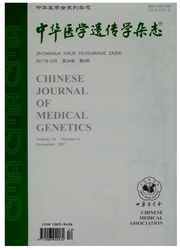

 中文摘要:
中文摘要:
目的探讨一个Usher综合征家系的致病基因突变。方法对一个疑似为Usher综合征Ⅱ型家系的所有11名成员进行全面的眼科检查和听力测试,并提取外周血基因组DNA,采用PCR和直接测序对先证者进行USH2A基因的突变筛查。以正常人和患者的基因组DNA为模版,分别构建包含USH2A基因第42外显子、第42内含子及第43外显子的野生型和突变型minigene真核表达质粒。采用脂质体法将携带minigene的质粒转染Hela细胞,通过实时定量PCR检测minigene的剪切情况。结果家系分析和临床诊断提示该家族患有常染色体隐性遗传的Usher综合征Ⅱ型。测序发现先证者的USH2A基因中存在纯合的C.8559-2A〉G突变。对其他家系成员进行测序验证发现该突变与疾病共分离。C.8559—2A〉G突变为剪切突变,可能引起第42内含子的剪切异常。Minigene结果证实该突变可导致第42内含子不能剪切,从而保留至成熟的mRNA中。结论USH2A基因C.8559—2A〉G突变是该Usher综合征Ⅱ型家系的致病原因。该突变可以导致USH2Apre-mRNA的剪切异常。
 英文摘要:
英文摘要:
Objective To investigate the disease-causing mutation in a Chinese family affected with Usher syndrome type Ⅱ. Methlxls All of the 11 members from the family underwent comprehensive ophthalmologic examination and hearing test, and their genomic DNA were isolated from venous leukocytes, PCR and direct sequencing of USH2A gene were performed for the proband. Wild type and mutant type minigene vectors containing exon 42, intron 42 and exon 43 of the USH2A gene were constructed and transfected into Hela cells by lipofectamine reagent. Reverse transcription (RT)-PCR was carried out to verify the splicing of the minigenes. Results Pedigree analysis and clinical diagnosis indicated that the patients have suffered from autosomal recessive Usher syndrome type IX. DNA sequencing has detected a homozygous c. 8559-2A〉G mutation of the USH2A gene in the proband, which has co-segregated with the disease in the family. The mutation has affected a conserved splice site in intron 42, which has led to inactivation of the splice site. Minigene experiment has confirmed the retaining of intron 42 in mature mRNA. Conclusion The c. 8559-2A 〉 G mutation in the USH2A gene probably underlies the Usher syndrome type Ⅱ in this family. The splice site mutation has resulted in abnormal splicing of USH2A pre- mRNA.
 同期刊论文项目
同期刊论文项目
 同项目期刊论文
同项目期刊论文
 期刊信息
期刊信息
